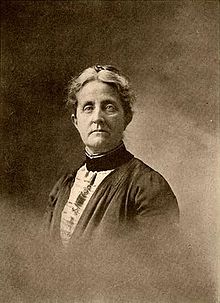Mary Watson Whitney
Mary Watson Whitney (born September 11, 1847 in Waltham , Massachusetts , † January 20, 1921 there ) was an American astronomer .
Life
Mary Whitney was born in Waltham in 1847 and attended public high school (secondary school) there. In 1863 she completed this and entered Vassar College , where she attended advanced courses from 1865. She was quickly influenced by the astronomer Maria Mitchell .
After graduating in 1868, Whitney returned to Waltham, took care of her widowed mother and taught at the Auburndale , Massachusetts School. In 1869 she traveled to Burlington , Iowa to observe the solar eclipse with her purpose-built Alvan Clark telescope . From 1869 to 1870 she attended Benjamin Peirce's lecture on quaternions at Harvard and heard from him privately about celestial mechanics . In 1872 she received her master’s degree in Vassar , then (1873–1876) she studied at the ETH Zurich .
She taught at Waltham High School from 1876 to 1881 before returning to Vassar to become Maria Mitchell's assistant. In 1888 she succeeded Mitchell on her professorship and director post of the observatory in Vassar.
Whitney was considered a very good and effective teacher. Since she had impressively demonstrated that she achieved great achievements in research and teaching, she was able to implement a large-scale research program in Vassar. It dealt mainly with binary stars , variables , asteroids , comets and the improvement of precision measurements on photo plates . Her students found jobs all over the United States. In 1899 Witney was inducted into the American Astronomical Society .
For health reasons, she withdrew from Vassar in 1910 and died in 1921. Her successor as professor and director of the Vassar College Observatory was her former student and assistant Caroline Ellen Furness .
Web links
- Biography at Vassar College
- Publications by MW Whitney in the Astrophysics Data System
- Obituaries for MW Whitney in the Astrophysics Data System
| personal data | |
|---|---|
| SURNAME | Whitney, Mary Watson |
| BRIEF DESCRIPTION | American astronomer |
| DATE OF BIRTH | September 11, 1847 |
| PLACE OF BIRTH | Waltham (Massachusetts) , USA |
| DATE OF DEATH | January 20, 1921 |
| Place of death | Waltham (Massachusetts) , USA |
